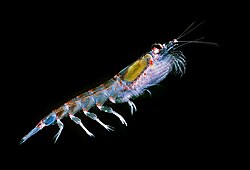Ice planet and antarctic jellyfish (crop)
Attribution:
Das Bild ist mit 'Attribution Required' markiert, aber es wurden keine Informationen über die Attribution bereitgestellt. Vermutlich wurde bei Verwendung des MediaWiki-Templates für die CC-BY Lizenzen der Parameter für die Attribution weggelassen. Autoren und Urheber finden für die korrekte Verwendung der Templates hier ein Beispiel.
Größe:
1840 x 1840 Pixel (4436633 Bytes)
Beschreibung:
Underwater Antarctic biodiversity (French scientific base in Antarctica). Identified as
Diplulmaris antarctica by Prof.
Andre C. Morandini:
| “
|
Sometimes it is not so easy to identify animals by photographs, but in this case we can see some important features.
It is a scyphozoan jellyfish of the order Semaeostomeae, due to the general body shape but mostly because of the marginal tentacles and elongated oral arms.
It is a member of the family Ulmaridae because the gastric cavity is divided in canals, as can be seen by transparency.
Subfamily Ulmarinae because tentacles arise from the margin and gonads are protrusive (the orange pleated tissue in the center).
The difference between the genera of this subfamily (Diplulmaris, Discomedusa, Floresca, Parumbrosa, Ulmaris, Undosa) are the number of sense organs (rhopalia) and the number of tentacles, besides some canal system organization.
As far as I can see the animal in the photo has 21 tentacles and 10 rhopalia (probably more of both). But the angle of the image does not allow me to see more.
I think it is a Diplulmaris antarctica, by the way from all valid species of the subfamily, this is the only one known from Antarctic waters. The species has 16 sense organs and 16-48 tentacles.
If you Google it, at least the first images are OK.
|
”
|
Weitere Informationen zur Lizenz des Bildes finden Sie hier. Letzte Aktualisierung: Wed, 10 Apr 2024 22:02:12 GMT
Relevante Bilder
Relevante Artikel
Antarktis
Die Antarktis umfasst die um den Südpol gelegenen Land- und Meeresgebiete, also im Groben den Kontinent Antarktika und den Südlichen Ozean. Sie ist damit eines der beiden Polargebiete. Als geographisch-astronomische Zone wird sie durch den südlichen Polarkreis begrenzt und reicht somit vom Südpol bis 66° 33′ südlicher Breite. Als ozeanografische Grenze gilt die antarktische Konvergenz bei etwa 50° südlicher Breite, wo das kalte antarktische unter das wärmere subtropische Oberflächenwasser absinkt. Die Zone zwischen 50° Süd und dem Polarkreis wird auch als subantarktisch bezeichnet. Seit der Definition des Südlichen Ozeans mit dem 60. Breitengrad (2000) beginnt sich diese Grenze auch auf den Antarktisbegriff auszuwirken. Die Subantarktis bildet jeweils die Südzone der umgebenden Meeresgebiete Südatlantik, Südpazifik und Südlicher Indischer Ozean.
.. weiterlesen

























